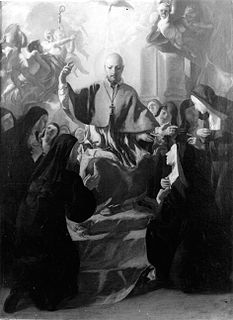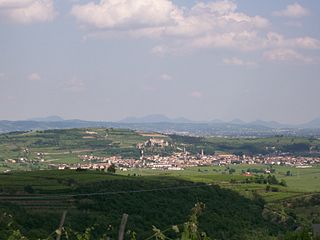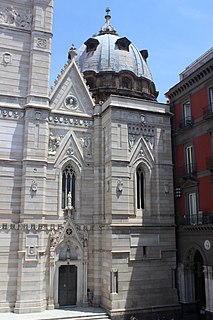
The Porta San Gennaro is one of the ancient gates of the city of Naples, located just southwest of the edge of the Piazza Cavour, just off the busy Via Foria and leading to a pedestrian alley, just east and parallel to Via Duomo.

The Porta San Gennaro is one of the ancient gates of the city of Naples, located just southwest of the edge of the Piazza Cavour, just off the busy Via Foria and leading to a pedestrian alley, just east and parallel to Via Duomo.
This is not the original location of this gate, which documents state was the original portal which lead north out of the city, and towards the Catacombs of San Gennaro. Documents from before the year 1000 speak of a gate of this name, legend holds that it was around during the time of the late Roman Empire. It appears to have once stood some 100 meters south on the same alleyway, adjacent to the church of Gesù delle Monache, and moved in 1537 by the Spanish viceroy Don Pedro de Toledo, in his efforts to enlarge the city. In doing so, he razed the towers that flanked the gate. These were likely similar to those now flanking the Porta Capuana. [1]
The Gate houses a small chapel, and the northern approach has a restored fresco (1656) belonging to Mattia Preti, the sole remainder of frescoes he painted at seven town gates, this one depicting San Gennaro and Francis Xavier showing devotion to the Immaculata and Child as an ex voto to spare the town from the plague. The southern approach has a Bust of San Gaetano (1659) by Bartolomeo Mori placed by members of the Theatine order. The inside gate, adjacent to an aedicule of the Virgin, has a small chapel-church, San Francesco dei Cocchieri, now deconsecrated and shuttered. [2] Coordinates: 40°51′18″N14°15′22″E / 40.855121°N 14.256151°E

Spello is an ancient town and comune (township) of Italy, in the province of Perugia in eastern-central Umbria, on the lower southern flank of Mt. Subasio. It is 6 km (4 mi) NNW of Foligno and 10 km (6 mi) SSE of Assisi.

Alatri is an Italian town and comune of the province of Frosinone in the region of Lazio, with c. 30,000 inhabitants. An ancient city of the Hernici, it is known for its megalithic acropolis.

Giovanni Lanfranco was an Italian painter of the Baroque period.

Pacentro is a comune of 1,279 inhabitants of the province of L'Aquila in Abruzzo, Italy. It is a well-preserved historic medieval village located in central Italy, several kilometers from the City of Sulmona about 170 kilometres (110 mi) east of Rome. Pacentro has been nominated as one of the "Borghi più belli d'Italia".

Lorenzo de Caro was an Italian painter, active in the late Baroque style in his native city of Naples.

Soave is a small comune of the Veneto region in the Province of Verona, northern Italy, with a population of roughly 6,800 people.

Castel Nuovo, often called Maschio Angioino, is a medieval castle located in front of Piazza Municipio and the city hall in central Naples, Campania, Italy. Its scenic location and imposing size makes the castle, first erected in 1279, one of the main architectural landmarks of the city. It was a royal seat for kings of Naples, Aragon and Spain until 1815.

The Church and Convent of the Girolamini or Gerolamini is a church and ecclesiastical complex in Naples, Italy. It is located directly across from the Cathedral of Naples on via Duomo. The facade is across the homonymous piazza and street from Santa Maria della Colonna. It is one block west of Via Duomo.

San Gennaro dei Poveri is a former monastery and church complex, later converted into a hospital for indigent located on Via San Gennaro dei Poveri #25 in the Rione Sanità, of the city of Naples, Italy. The elongated complex rises towards Capodimonte, lying just south of the domed Basilica dell'Incoronata Madre del Buon Consiglio.

Via dei Tribunali is a street in the old historic center of Naples, Italy.

San Pietro Martire is a Roman Catholic church in Naples, Italy. It is located directly across from the principal building of the University of Naples on the main street, Corso Umberto corner with Via Porta di Massa, near the port area. In the piazza in front of the church is a statue of Ruggero Bonghi.

The Catacombs of San Gennaro are underground paleo-Christian burial and worship sites in Naples, Italy, carved out of tuff, a porous stone. They are situated in the northern part of the city, on the slope leading up to Capodimonte, consisting of two levels, San Gennaro Superiore, and San Gennaro Inferiore. The catacombs lie under the Rione Sanità neighborhood of Naples, sometimes called the "Valley of the Dead". The site is now easily identified by the large church of Madre del Buon Consiglio.

Valmontone is a comune (municipality) in the Metropolitan City of Rome in the Italian region Lazio, located about 45 kilometres southeast of Rome.

The Royal Chapel of the Treasure of St. Januarius, or the Reale cappella del Tesoro di San Gennaro, is a chapel located in the Cathedral of Naples, Italy, and dedicated to St. Januarius, patron saint of the city. This is the most lavishly decorated chapel in the Cathedral, and contains contributions by the premier Baroque artists in Naples.

Santa Maria della Stella is a church located on Via Stella 25 in the quartiere of its name in Naples, Italy.

Santa Maria della Sapienza is a Roman Catholic church, located on Via Costantinopoli in central Naples, Italy.

The church of San Biagio Maggiore also known to its locals as 'Santa Patrizia' is a small former religious edifice located at the intersection of Via San Biagio dei Librai and Via San Gregorio Armeno, which was an integral part in the city center of Naples, Italy. It is adjacent, and for many years integral to the church of San Gennaro all’Olmo.

The Catacombs of Saint Gaudiosus are underground paleo-Christian burial sites, located in the northern area of the city of Naples.

The Porta Nolana is the remnant of one of the medieval city gates in Naples, Italy. It is located in Piazza Nolana, near a local train station, Napoli Porta Nolana with the Circumvesuviana lines, and a bustling local pedestrian market, Mercato di Porta Nolano, known for seafood. It takes its name from the road that lead to Nola.

The Porta Romana, once known as the Porta San Pier Gattolino was the southernmost gate in the 13th-century walls of the Oltrarno section of Florence, region of Tuscany, Italy. It stands at the confluence of a number of roads: accessed from north by Via Romana, Via de' Serragli, and Viale Francesco Petrarca. In addition, a central road along the Boboli Gardens begins near the gate, and allowed the inhabitants of the Pitti Palace to exit and enter Florence with minimal travel on city streets. Beyond the gates are the Via del Poggio Imperiale and Via Senese. The latter led to Siena and points south such as Rome, hence the name. When the majority of the defensive walls of Florence were razed in the 19th century, only a few, and sometimes partial gate structures were left standing including San Gallo Gate, Tower of San Niccolò, and this gate with a snippet of merlonated wall.